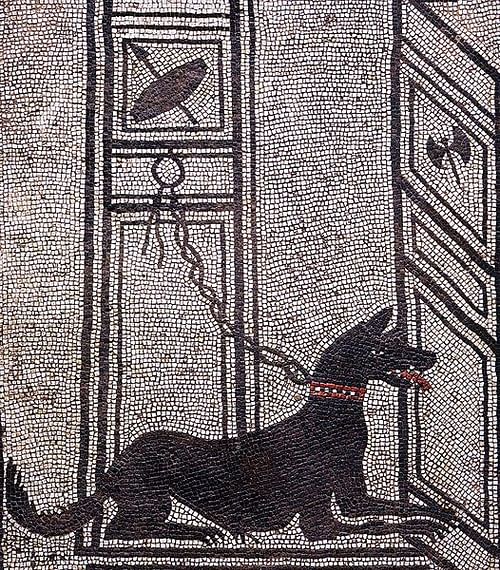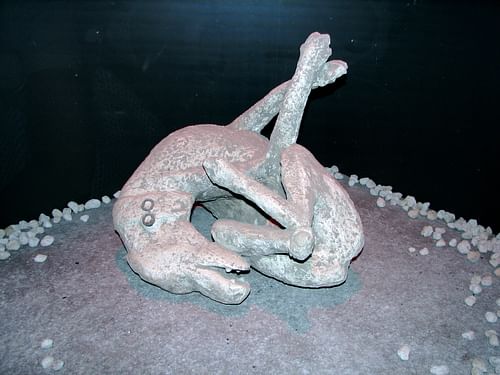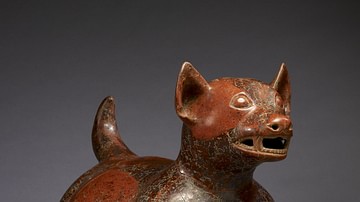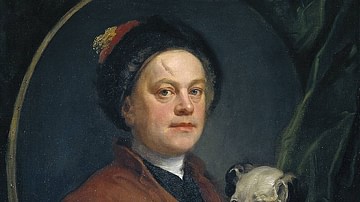Dogs were highly valued in ancient Rome, as they were in other cultures, and the Roman dog served many of the same purposes as it did in, say, Egypt and Persia - as hunters, guardians, and companions - but with a significant difference in focus.
Like the Egyptians, the Romans created their own artistic dog collars – some of gold – and, although dogs did not feature in the Roman afterlife (as they did with the Persians), they were considered the best protection against ghosts or evil spirits. The central difference between the Roman view of dogs and that of other cultures is that the Romans viewed dogs far more pragmatically.
Roman culture across the board was more grounded, for the most part, than others, and their view and treatment of dogs fit this paradigm. A dog collar in Egypt was an expression of the animal's individual spirit; a dog collar in Rome – even one of gold – served a completely practical purpose.
The dog was a companion, guardian, hunter, professional fighter, tracker, fellow warrior, and was offered to the gods in sacrifice during some eras. It served to keep one warm at night, alerted an owner to the presence of unseen spirits, and was regularly depicted in Roman myths and legends in practical roles.
They were originally bred and used by the Etruscans of Italy prior to the rise of Rome (how the Etruscans viewed them is unclear) and the Romans made full use of the dog in every aspect of their lives, cared for them as they would family members, and honored them when they died with tombs and epitaphs.
Dogs in Myth & Practical Advice
Dogs, and their wolf-ancestors, had a long history with the Romans as evidenced by the famous tale of the mythical founders of the city. Romulus and Remus were said to have been suckled by a she-wolf as infants before they grew up, Remus was killed, and Romulus founded Rome in April of 753 BCE. This myth provides a divine origin for the city but, as far as dogs go, foreshadows their later appearance in a number of important Roman myths and tales in which they serve the same sort of practical purpose as the she-wolf.
The goddess Diana, the huntress, is often seen with her dogs and one of the most enduring tales from Ovid (l. 43 BCE - 17) is of Diana and Acteon, the young hunter who pays for an accidental indiscretion with his life. Out on a hunt with his dogs, Acteon chances upon the goddess bathing and, to ensure he will never tell what he saw, she changes him into a deer who is killed by his hunting dogs. Here, the dog performs the role of protector and avenger. Acteon is punished for seeing what no mortal should see and the mystery of the divine is kept by the gods.
The goddess Trivia (the Roman version of the Greek Hecate) was also associated with dogs. Trivia was the goddess of ghosts, graveyards, witchcraft, and crossroads whose approach was silent and invisible but who, like Hecate, could be seen and heard by dogs. As with Hecate, a dog who seemingly barked at nothing was thought to be warning the family of the approach of Trivia or one of her ghosts.
The Roman writer Varro (l. 116-27 BCE) is among the earliest authors to deal with the subject of dogs on a purely practical level. He claims that every home, especially a farm, should have a guard dog and a hunting dog. Varro emphasizes the importance of the watch dog and follows the Greek policy that it should be white in order to clearly be distinguished from a wolf at night. He also suggests these dogs be fitted with a thick, studded collar (known as a melium) to protect its throat from wolf attacks. The melium collar, Varro claims, would prevent future wolf attacks - even on dogs wearing no collar - because once wolves had experienced the pain of the melium they would come to fear dogs.
Nemesianus (l. c. 283) was among the later Latin writers and, between Varro and him, many others had addressed the subject of dogs and their uses. Nemesianus distills advice from earlier eras in his Cynegetica ("On the Hunt") when he suggests the best ways of breeding dogs (beginning at the start of the year) and how to know which puppies are most worthy of attention. Nemesianus contends that a large litter of puppies will wear out the mother and some of inferior quality may deny superior dogs of food.
He therefore suggests that one make a ring of fire around the puppies, with the mother on the other side of the flames; the mother will save those of the best quality first and one may then focus one's attention on them at the expense of their lesser siblings (Cynegetica of Nemesianus, 497). Whether this advice was followed is unknown but the breeding of dogs in Rome, especially for hunting, was considered a serious business and dogs of high quality were much sought after.
Popular Breeds
Among the most popular breed was the Vertragus, a hunting dog of exceptional speed and skill which was also prized for its beauty. The writer Grattius (l. 63 BCE - 14 CE) praises the Vertragus for its refined features but more for its incredible speed, writing how it runs "swifter than thought or a winged bird" so that hunters could now chase game on horseback with their dogs ahead of them as opposed to the more cumbersome method of hunting with Laconian hounds who moved more slowly (Cynegeticon, 171). The Vertragus (ancestor of the modern Italian Greyhound) served as a guard dog as well as a hunter and also provided an owner with an additional benefit: warmth. People would sleep with their Vertragus hound because the dogs generated a significant amount of heat.
Another breed, more popular with women and children, was the Canis Melitae or Melitan (the Maltese) best known among ancient Romans for sleeping comfortably on one's lap and therefore known as a lapdog. The Melitan was a status symbol in that only the upper class could afford one and served another purpose besides warmth and companionship: they were thought to draw fleas away from their owners. The Melitan may have been the breed of dog written of so lovingly in an epitaph of a tomb dated c. 100-200. The inscription reads:
Bedewed with tears I have carried you, our little dog, as in happier circumstances, I did fifteen years ago. So now, Patrice, you will no longer give me a thousand kisses nor will you be able to lie affectionately 'round my neck. You were a good dog and, in sorrow, I have placed you in a marble tomb and I have united you forever to myself when I die. You readily matched a human with your clever ways; alas, what a pet we have lost! You, sweet Patrice, were in the habit of joining us at table and fawningly asking for food in our lap, you were accustomed to lick with your greedy tongue the cup which my hands often held for you and regularly to welcome your tired master with wagging tail. (Courtney, no. 204, Inscr. It. I.1.228=CLE 1176)
The Melitan became especially popular subjects for chous, Greek ceramic drinking vessels usually decorated with figures, on which they are depicted with and without collars. A chous from Athens, known as Melitan Dog with Grapes, dated to 450-435 BCE, shows a Melitan with a thin lightly ornamented collar. These are narrow, delicate collars, sometimes adorned with bells. They were like those of the Vertragus when it was not on a hunt; when hunting, the Vertragus would have worn a spiked collar or a thick collar of leather.
Dog Collars & the Buckle
The speed of the Vertragus encouraged the Romans to race them. This led to the development of a light-weight leather collar and leather thong-leash, the lyam, which passed through a metal ring on the collar, the two ends held in the hand of the owner or handler. Metal collars were considered too heavy for racing hounds and, further, stained the animal's neck an unattractive gray.
Racing collars were painted in different bright colors to easily identify the winning dog. At the start of the race, the dogs were lined up with their handlers and, at a signal, the person would let go one end of the thong-leash and release the dog on the track. Arrian (l. 86-160 CE) describes these collars with their metal ring but fails to mention how they were fastened. They could have had clasps or even buckles.
Pliny the Elder (l. 23-79 CE) mentions far more elaborate and expensive dog collars in his works, claiming that a collar of gold will calm a dog and keep it from incessant, needless barking. These gold dog collars were held by clasps which interlocked and were engraved with the owner's name and sometimes a clever saying relating to the dog's personality. This practice would lead to the same on the slave collar, worn by many of the enormous population of slaves throughout Rome, giving the slave's name and owner's name and address. Slave collars, of course, were far from gold and this distinction was the norm in Rome as dogs were almost always treated better than slaves.
Columella (l. 4-70 CE), another Roman writer, claims that a dog is the most important aspect of home-owning and the first purchase one should make upon establishing residence. He echoes the advice of Xenophon (l. 430 to c. 354 BCE) to keep the name of a dog to one or two syllables for ease in training "so that each may obey more quickly when he is called" but discourages people (farmers, specifically) from owning hunting dogs which will only lure them away from their home and duties in pursuing the hunt (On Agriculture, Book VII.xii.13).
Columella emphasizes the importance of owning a dog to guard the farm, home, one's produce, and livestock. He also suggests these guard dogs be of two different colors: a white dog who will protect the premises at night and be easily differentiated from a wolf or other predator and a black dog to intimidate would-be thieves by day and be invisible to the same at night. He suggests specific dog names such as Ferox ("savage") or Celer ("speedy") which should fit the dog's individual personality and serve as warning to others of what the dog was known for.
The Romans invented the buckle for use in military gear (though the concept could have come from China) and it afterward made an appearance on dog collars. Exactly when this happened is unclear, but it was prior to 79 CE when Mount Vesuvius erupted and buried the cities of Pompeii and Herculaneum. A dog discovered among the ruins of Pompeii wears a buckle collar inscribed with praise for saving its master's life from a wolf attack. The most popular collar, however, appears to have been the metal spiked work of Greek origin which was used in hunting, for guard dogs, and especially in the arena for dog fights.
Dogs in War
The Molossian (probably the ancestor of the Neapolitan Mastiff) was one of the preferred fighting breeds, equipped with its large spiked collar, and was also the breed that accompanied the Roman army on their conquests throughout the world of the Mediterranean and beyond. The Molossian is thought to have been eventually bred specifically for combat and was the Romans' main war dog, though not their only one.
In 231 BCE, the Roman consul Marcus Pomponius Matho took up the campaign in Sardinia which his brother had failed to complete. The Sardinians practiced guerrilla warfare, striking at the Roman legions and then vanishing into caves and woods. According to the historian Zonaras (l. 1074-1130), Marcus Pomponius "sent for keen-scented dogs from Italy" who were able to track the Sardinians to their hideouts and alert the handlers who followed them. The campaign in Sardinia had been dragging on for years without showing any sign of resolution until these dogs were brought into the campaign. Marcus Pomponius secured his victory and was able to return to Rome in triumph.
The precise breed of the "keen-scented dogs" Marcus used is unknown but they are thought to have been hounds, perhaps the Vertragus. The Molossian, however, is well documented as the most formidable war dog of the Romans. These dogs are claimed to have often formed their own companies among the troops and were protected by armor and the thick, spiked, metal collars formerly used to protect the dogs from wolves.
Although there is evidence of Molossians being used as guard dogs in camps and as messengers, there is some controversy regarding the claim they were used in battle. Writer Ria Horter of The Canine Chronicle, for example, cites a scholar by the name of Dr. Robert van der Molen who claims he has proven that dogs were never used in battle in the ancient world. Horter cites Molen's work, Dogs in the Greek and Roman World, in claiming that dogs never featured as regular combatants on the field.
This claim, however, is contested by authors who point to military companies of Molossians under Roman handlers on the front lines. Further, ancient sources such as Pliny the Elder, Plutarch, Polybius, and others write of a number of different types of dogs used in the Roman army during different eras: canes pugnaces (attack dogs in chain mail and spiked collars, also the premier fighting dog in the arena), canes villatica (guard dogs), canes nare sagaces (tracking dogs) and canes pedibus cleres (chasing dogs) among others.
The breed now known as the cane corso (then known as cane pugnaces) was definitely used in battle. This was a large mastiff regularly used as a guard dog; its modern name, in fact, can be translated as 'guard dog'. The cane corso was sometimes used as a piriferi (fire-bearer) on the battlefield according to modern-day writers (see bibliography below) though, as noted, this claim continues to be challenged. According to these sources, the Romans would strap buckets of flaming oil to the backs of the dogs and release them toward the front lines of the opposing cavalry.
The cane corso is most likely the dog often depicted in ancient engravings as it frequently was chosen as a farm dog to protect the home and livestock as well as a hunting dog and so was a familiar figure in popular use. In later writings the breed seems to become associated with the Molossian.
Julius Caesar, invading Britain in 55 BCE, met opposition from Celtic warriors with their own dogs which are frequently identified as the English Mastiff but Caesar himself never names them. Historians believe it more probable Caesar encountered Molossians which had been brought to Britain by Carthaginian traders. The Molossians would have interbred with the local dog population to produce the Mastiff, but it seems unlikely the Mastiff would have already been a breed in Britain when Caesar arrived there.
Conclusion
The use of dogs in Roman warfare under Marcus Pomponius and Polybius's report of the cane corso seem to contradict the claim by van der Molen as cited by Horter. The Romans held dogs in high esteem and many works were written regarding breeding, training, and care for the animals. It would hardly be surprising that the Romans, ever practical, would have used dogs in combat.
The Romans relied heavily on their dogs to assist and protect them in their daily lives and so, although it may seem a contradiction to a modern audience, it is not surprising that dogs were also offered in sacrifice to the gods. As with other cultures, the Romans sacrificed the best of what they had, not what they could easily do without, and dog sacrifices are the best example of this.
In the same way, the fighting dog – whether in the Colosseum or a local ring – was far from poorly used but, rather, highly honored and well-cared for. The owner's reputation and, often, livelihood depended on the dog's performance in a fight and they received better care and greater attention than many of the slaves in Rome or even some family members.
There is some evidence that dogs could be seen in a negative light - the Romans, after all, coined the phrase dies caniculares – “the dog days of summer” – associating dogs with intolerable heat because of their link to Sirius, the dog star, which was prominent in that season, but positive associations far outweigh the negatives. The most frequent depiction of the dog in ancient Rome is of a loyal servant, a trusted guardian, and always as a close companion.










